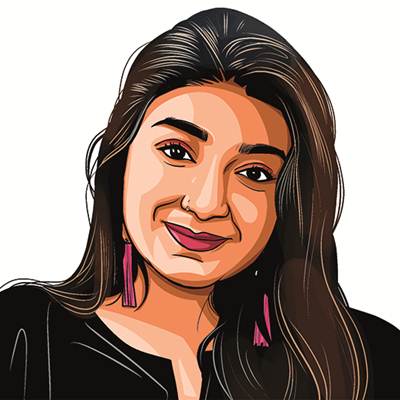Opinion Shrinking the Muslim woman’s choice
Sayyeda Maryam Ziya writes: Karnataka HC verdict threatens to confine her to domestic space, reduce her chances of entering the mainstream.
 Students enter a pre-university college in Karnataka amid the hijab row. (Reuters Photo/File)
Students enter a pre-university college in Karnataka amid the hijab row. (Reuters Photo/File) As a young woman, I was relieved to read the triple talaq judgment of the Supreme Court in August 2017. The judges, led by the Chief Justice J S Khehar, set aside instant triple talaq in the case otherwise known as the Shayara Bano versus the Union of India and others. Coming after several lynching incidents, beginning with Mohammad Akhlaq in Dadri in September 2015, the verdict went a long way towards assuaging the fears of the minority. The Indian government wanted to get rid of patriarchal practices happening in the name of religion but there was no attempt to tamper with the religious rights of the minorities. It was heart-warming to see the five judges from five different religions – Chief Justice Khehar, Justice Kurian Joseph, Justice R F Nariman, Justice U U Lalit and Justice S Abdul Nazeer – quoting from the Quran’s Surah Baqarah and Surah Talaq to rebuff any allegations that they had gone against either the letter or spirit of the Quran in their verdict. Besides giving the strength to fight fundamentalists within the community, the verdict also reinforced my confidence as a Muslim woman in India.
Unfortunately, those feelings are endangered following the Karnataka High Court judgment in the hijab case. “We are of the considered opinion that wearing of hijab by Muslim women does not form a part of essential religious practice in Islam,” the bench of three judges said, thereby refusing to strike down the state government’s order restricting Muslim women from wearing the hijab in educational institutions. When sundry maulanas insist on Muslim women wearing a hijab or, in many cases a full burqa, they do not ask a woman’s views on the subject. Likewise, the three judges have taken into account neither a woman’s view on the hijab nor the condition of one habituated to the hijab having to step out without it. Would such a woman still step out or just retreat to the privacy of her home? The Prime Minister, soon after coming to power, started a “Beti Bachao, Beti Padhao” campaign to protect and educate the girl child.
Today, the Karnataka HC verdict is a setback to Muslim girls in their pursuit of education. Is uniformity of dress more important than dissemination of education? Can India afford to send back these students, many of whom would have struggled to convince their parents to send them out for education in the first place, back home, or into the clutches of conservative clerics? Take the case of Tamil writer Salma, whose parents withdrew her from school at the onset of puberty. Salma managed to pursue her dreams of becoming a writer from the confines of her marital home. Do we want more girls to face similar challenges in Karnataka and elsewhere?
In today’s India, the attempt to invisibilise Muslims is an ongoing project. It began with their alleged dietary habits, when the supposed gaurakshaks started attacking unarmed Muslim men over unsubstantiated allegations of cow slaughter. More recently, we had the sorry spectacle in Gurugram where right-wing mobs disrupted Friday prayers for weeks on end. The administration, instead of protecting the worshippers, asked them to reduce the number of prayer sites in the city. From over 130, the prayer sites came down to 20. Muslims were effectively invisibilised in Gurugram. The Karnataka verdict will similarly invisibilise Muslim women.
This verdict seems to be putting Muslim women in a lose-lose position when it could have simply upheld the idea of education. The hijab issue is important as the stakeholders here are young, female students who wish to cover their head in an educated, democratic state. These students come with the desire to learn and become independent, without it taking away from their personal religious identity. Women’s oppression is multifaceted and when the state takes away the choices of a Muslim female student at the level of the classroom, can we expect a brighter future for the girl child? Far from enabling them to enter the mythical mainstream, it will send Muslim girls back into their little islands of domestic life with no opportunity for professional attainment. The hijab ban in the classroom is not only a ban on identity but also on female expression, choice, development and the ability to break away from the shackles of chauvinists, whether judges or religious fundamentalists.
This column first appeared in the print edition on March 22, 2022 under the title ‘A question for the court’. The writer is a freelance journalist and student of political science at Delhi University.





